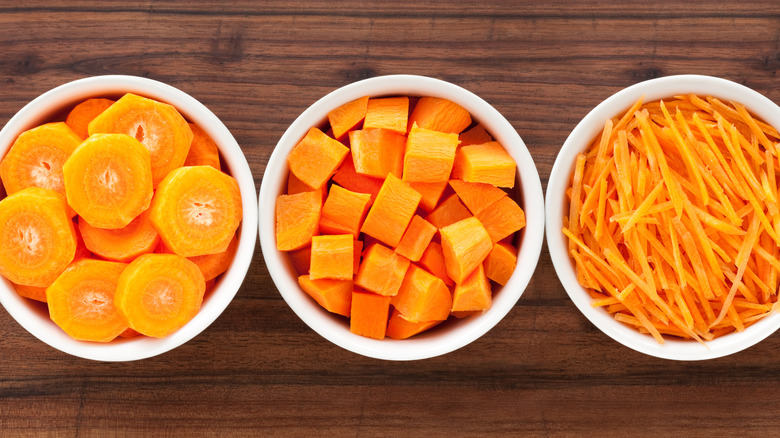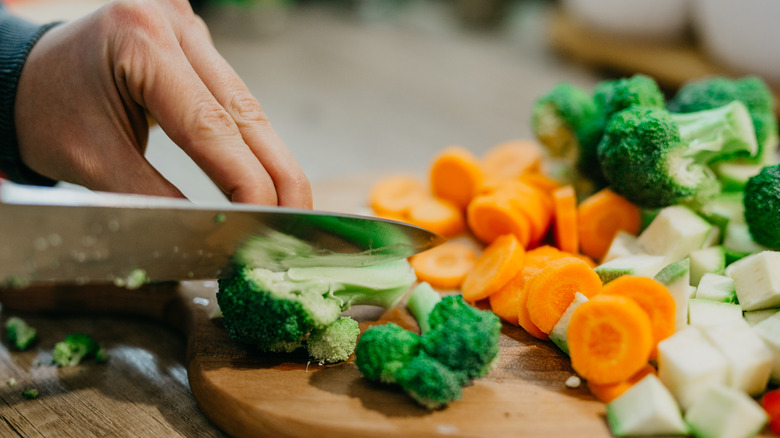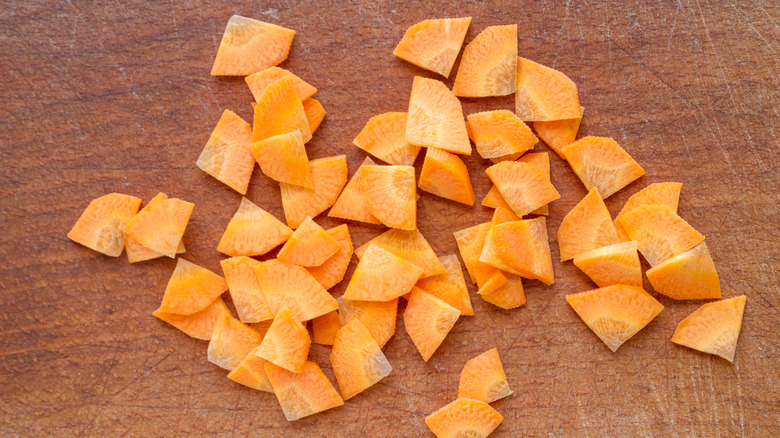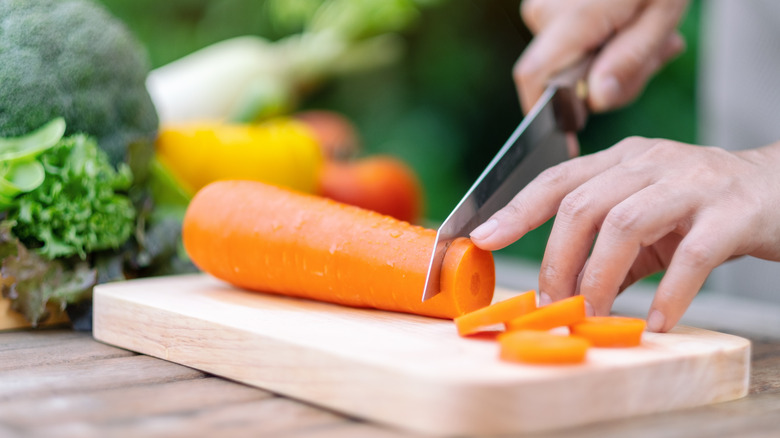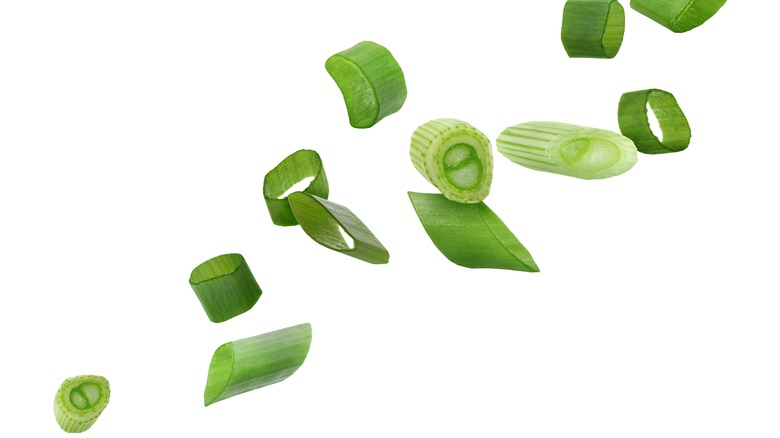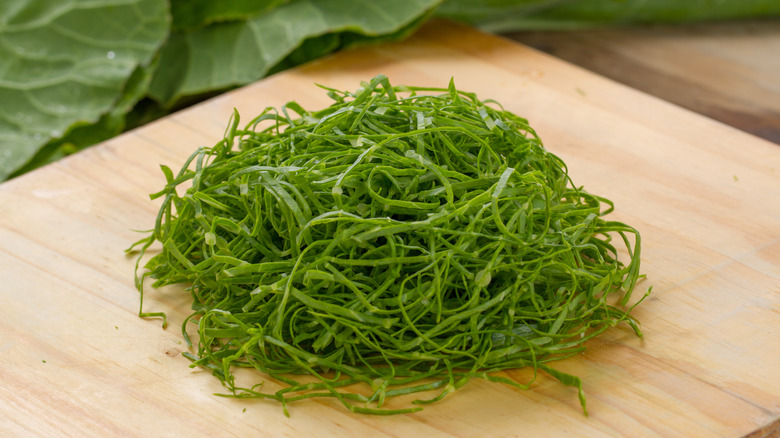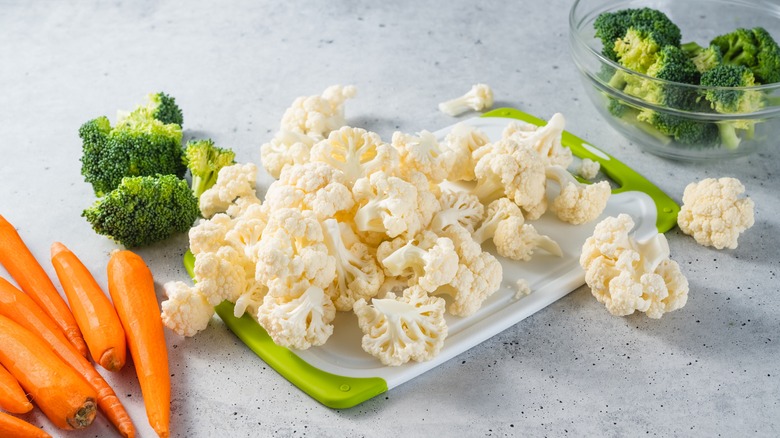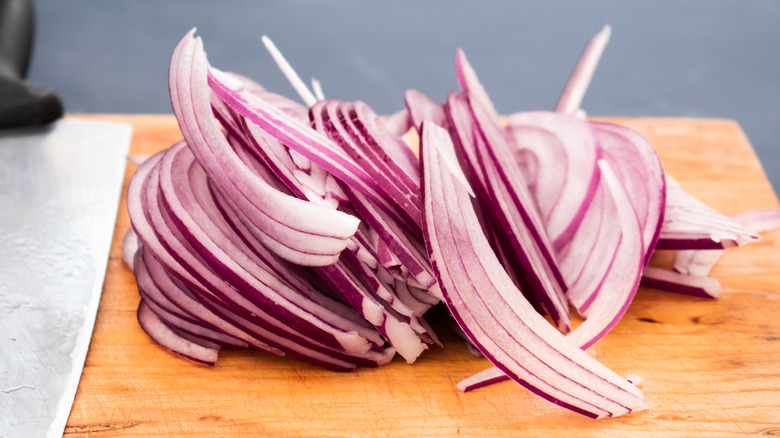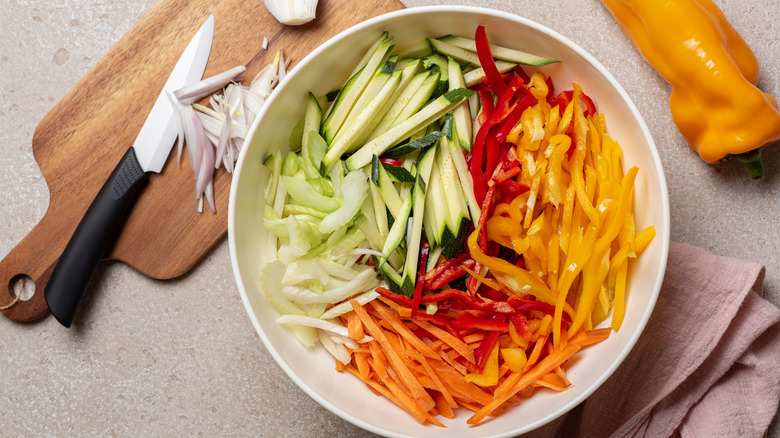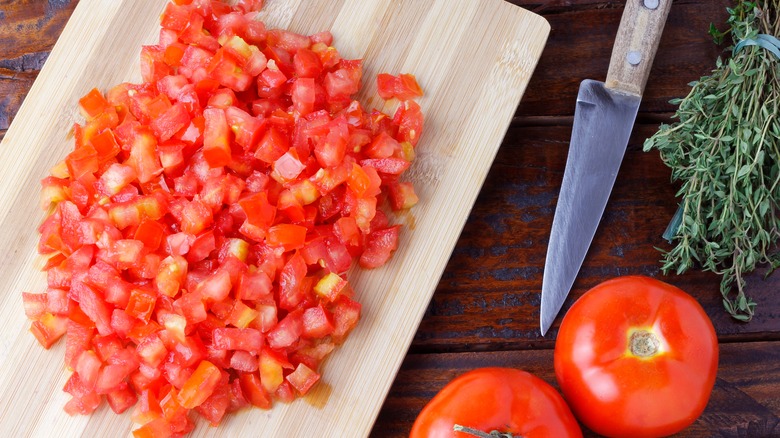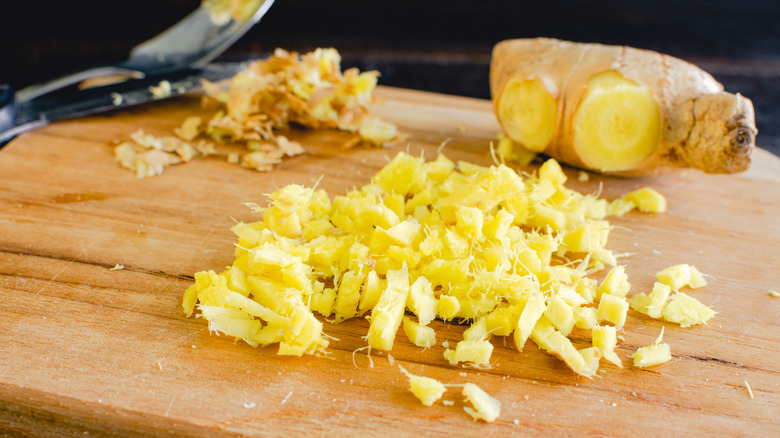11 Types Of Knife Cuts Everyone Should Know
Not all knife cuts are created equal, and not every style of chopping vegetables works for every meal preparation. Choosing the correct method of cutting your vegetable is more important than you may think. The size and thickness of your veggies impact their cooking time and the overall texture of your meal. Uneven sizes of cuts mean that some of your food will be undercooked, while others are mushy. A chiffonade slice will wilt and become gummy if put into a slow cooker while a chunky rough chop will look messy in a salad. There are many different styles of knife cuts, and we're here to break them all down for you and explain how they can be used most effectively.
The most important first step in getting the perfect cut on your vegetables is to have the proper, sharpened knife. A chef's knife, either eight or 10 inches, is the best tool you can use in the kitchen. Make sure you keep your knives sharp to ensure your own safety and the best knife cuts. With that in mind, here are the types of knife cuts worth knowing.
1. Rough chop
The most basic cut of them all is the rough chop. This is the cut that you might use when your knife cuts are not going to be on display. For example, if you're cutting potatoes that are going to be mashed or chopping zucchini you're going to roast and purée into a soup base. The sizes don't have to be exactly precise and the shape of the vegetables doesn't have to be uniform. Cutting up boiled potatoes that you're going to toss into a bowl to be mashed with cream and butter is more about just making your job in the kitchen easier than showing off your skills with your knife.
You've probably been doing a rough chop without even realizing it. It's all about just cutting the food into "roughly" the same size. This is the ultimate "don't sweat it" chopping style. And if you're throwing together a salad in a rush, you might not care about the shape of your cucumbers. Rough chop away.
2. Paysanne cut
Similar to the rough chop is the paysanne cut. Originating from the French word for "peasant", this is a rustic style of cut. With the paysanne cut, the size is more important than the shape of the vegetables. Your pieces should be approximately ½ inch by ½ inch by ⅛ inch, but the edges don't need to be squared or precise. The shapes can be rounded or imperfect. That's the flawed beauty of the paysanne cut. It calls to mind homemade food, rustic stews, and hearty meat pies filled with vegetables that were cut by hand.
The paysanne cut allows the flavor to release evenly from vegetables while they cook while presenting a welcoming aesthetic that gives your food a very approachable appearance. You'd most often use this cut when chopping vegetables for soups, stews, or other rustic fare. Size matters when it comes to cutting vegetables for soups. You want a size that will allow the vegetables to hold their texture and not turn to mush during the cooking process while also fitting into a soup spoon for easy eating. The paysanne cut will serve you well, especially during soup season.
3. Rondelle cut
Following the theme of organic slicing methods, the rondelle cut is one that allows the shape of the vegetable to dictate the shape of the cut. This is a coin-shaped cut that comes from cylindrical vegetables like carrots, cucumbers, eggplants, and squash. The measurements for a rondelle cut depend on the vegetable itself. The only rule that you want to follow is to keep the thickness the same during your slicing.
Rondelle cuts are often found in salads or raw vegetable platters, as their shape makes excellent scoops for dips or dressings. It's also a great cut for roasting, as it exposes a broad surface area of the vegetable for cooking and browning. It's also great for creating shingled dishes like scalloped potatoes and eggplant Parmesan. For vegetables like cucumbers or zucchini, you can either peel the outer skin off or leave it on depending on your preference.
4. Bias cut
When you're looking to upgrade from the rondelle cut, you want to start cutting on a bias. That means slicing the food at an angle to produce longer sides with more exposed surface area. Cutting longer foods like carrots or parsnips on an angle makes for visually appealing side dishes for your meal and it helps break down the fiber of these dense vegetables while they cook to make them easier to chew and digest.
This cut is also great for garnishes. Leeks, scallions, and chives are all flavorful veggies that are also often used to add a pop of color and texture on top of dishes. Instead of chopping straight down the length of the stalks of these veggies, angle them and slice on a bias so that you end up with elongated spears that look much more elegant than lopsided ovals. It takes no additional effort, but it makes your meal look like it came directly from a professional kitchen.
5. Chiffonade
Flossy and elegant, the chiffonade cut comes from the French word for ribbon. This is a beautiful knife cut that is used almost exclusively on leafy greens and herbs. Chiffonaded greens are typically used for garnishes and delicate slaws or salads.
The ideal type of herbs to chiffonade include those with broad leaves, like sage, basil, and mint. Cutting the herbs into thin strips not only releases the fragrant oils into the dish, it also makes them more palatable to eat (biting into a whole sage or basil leaf can be super overpowering). Slicing ribbons of mint is also a fantastic way to add some minty goodness to cocktails and desserts.
With larger leafy greens like kale and romaine lettuce, cutting in the chiffonade style helps break down the tough fiber that makes the leaves difficult to chew. Kale, especially benefits from the chiffonade cut along with a dash of salt to make the notoriously chewy green much easier to approach.
6. Floret cut
The floret cut is a hyperspecific knife cut that is used on cauliflower and broccoli. The heads of the vegetables are made up of lots of smaller florets growing off a fibrous central stem. The easiest way to work with these vegetables is to remove the individual florets from the main stalk. Unless you are eating the veggies raw, the biggest goal with the floret cut is to make sure that the florets are cut to the same approximate size to promote even cooking or steaming.
The best way to cut florets is to use the tip of your chef knife, or use a smaller paring knife, and slice the slender stalks from the central thicker stem. Once all the florets have been removed, you can then trim them down to similar sizes. Florets naturally vary in shape, so getting a consistent cut isn't the name of the game, just make sure that the size is appropriate for your cooking methods.
7. Emincer cut
The emincer cut is another very specific knife cut that is used almost exclusively on onions, shallots, and garlic. Although the word looks like it might translate to "mince", it's actually more of a paper-thin slice. "Mince" is French for "thin," and a proper emincer cut should be fine enough to read newsprint through.
Other than looking striking in salads, when you emincer onions and shallots, you take a lot of sting out of the veggies in their raw form. For a lot of people, the idea of eating a raw slice of onion is too overpowering. By slicing them razor-thin, you're releasing the onion flavor without the stinging heat that would come with a thicker slice. Emincered onions and shallots also caramelize faster and cook more easily, so they're fantastic for quick dishes like stir-fry. This cut takes some practice to perfect, but once you have the hang of it, you'll never cut your onions any other way.
8. Baton and batonnet cut
Now we're starting to get down to the more subtle differences in cuts. The next few cuts on the list are going to seem pretty similar on the surface. First, we come to the baton cut. This is a stick-like cut that measures ½ inch by ½ inch by 2½ inches. This is one of the largest formal knife cuts and is used for things like steak fries. Because of its large size, it's used mostly for finger foods.
The batonnet cut is the baton cut's little sister, measuring ¼ inch by ¼ inch by 2 inches. Carrot sticks, fruit, and other crudité are most often cut into batonnet-style sticks. This cut is sturdy enough to be used for dipping and still makes excellent finger food. Shoe-string fries are also cut batonnet style, which makes them crispier than steak fries. The slight size difference might not be immediately apparent to the untrained eye, but the batonnet cut is what is most often seen in the wild.
9. Julienne
The next size down from the batonnet is the julienne cut. This cut measures ⅛ inch by ⅛ inch by 2 inches. This slender cut is most often seen in stir-fry recipes because its thinness allows the vegetables to cook quickly and evenly. The julienne cut is elegant both in cooked dishes and also in salads. This cut is a little too thin to be used for dipping as the sticks aren't as sturdy as a baton or batonnet cut, so its best use is for quick-cooking dishes.
The easiest way to get this cut is to slice ⅛ inch thick planks from your vegetable, then cut those planks into matchstick-like rods. It might seem daunting at first, but once you've practiced, this will soon be your most utilized knife cut. The ease with which julienned vegetables cook will cut your dinner prep time down. It will also make your dishes look elegant with the elongated slices of vegetables.
10. Dice cut
The dice cut is one that can describe cuts of varying sizes. There are the large, medium, and small dice, all of which are cubed cuts that come from slicing down the length of the baton, batonnet, or julienne rods. The large dice measures ½ inch by ½ inch by ½ inch, the medium dice is ¼ inch by ¼ inch by ¼ inch, and the small dice is ⅛ inch by ⅛ inch by ⅛ inch.
Large dice is often used on meat that you would use for stewing or slow cooking. Squash, pumpkin, or other large vegetables can be cut into a large dice to speed up the cooking process. Soups and stews benefit from the medium dice, especially for hearty vegetables like turnips and potatoes which can withstand prolonged cooking. The small dice cut is best for salsas or other scoopable dips. The small cut fits easily onto chips and also releases the most flavor from your raw vegetables.
11. Mince
Mincing is another generalized term that means to chop something very finely. There aren't exact measurements for a mince, but it involves breaking the food down to a very small size. Often this cut is used for aromatics like ginger, garlic, and shallots. These foods tend to be very strong in flavor and need to be cut into tiny pieces to be most easily incorporated into meals.
Mincing allows the aromatic oils of the food to be released. It also allows the fibrous material of the vegetables to break down during the cooking process, meaning that you won't find yourself chewing on annoying bits of ginger in your stir-fry. Mincing herbs also allows them to be more easily blended into sauces and dressings. The small size allows for even distribution throughout the dish, so you don't end up with one overpowering bite of garlic or basil and the consistency of your final product is nice and smooth.
